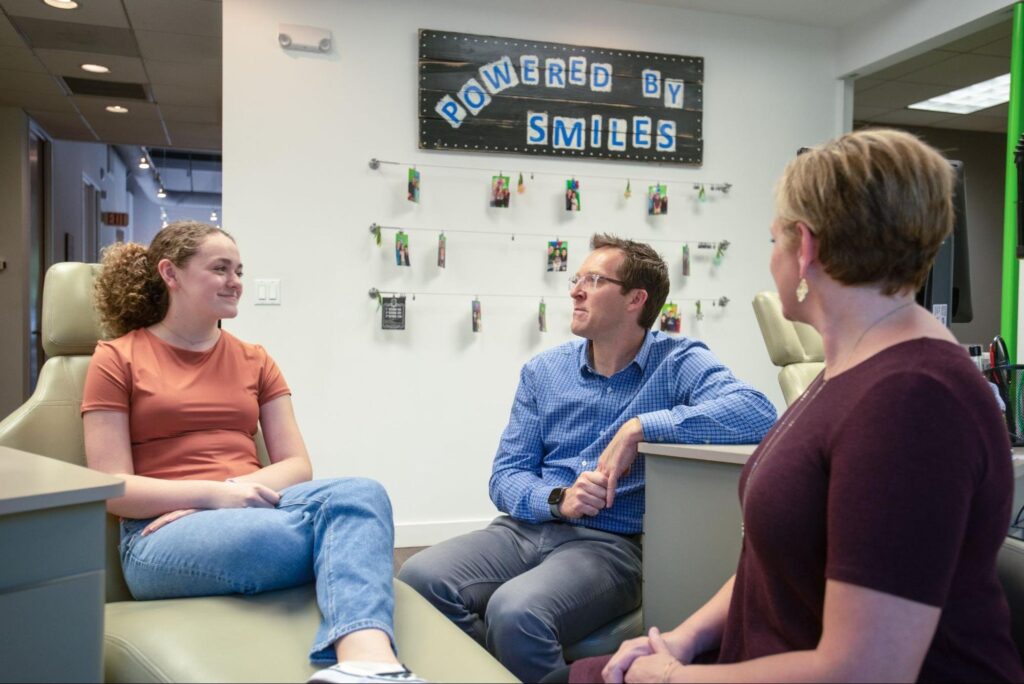When you’re a kid, and your friend gets braces, it’s like one day, their teeth are just… fixed. But have you considered how that happens? There’s more to it than you think! Hunter Family Orthodontics has a comprehensive explanation for this common question: How do braces move teeth?
Different Approaches
There’s some initial ground to cover before talking about how braces shift your teeth—most importantly, the different types of braces/alignment methods and the components of braces.
- Metal braces are the traditional choice for many patients, especially our youngest ones. They are time-tested and provide increased durability compared to alternative methods.
- Clear braces are similar in structure, with most of the same components. The brackets here are made of a ceramic material as opposed to metal, which can give a more seamless appearance.
- Clear aligners like Invisalign are an approach that eliminates these basic components in favor of sets of plastic trays. Like regular braces, they shift teeth over time—but the process can look quite different.
Components of Braces
For metal braces and clear braces, a number of parts work together to shift your teeth into their desired positions.
- Brackets: Attached to each tooth with a unique adhesive, these small brackets form an integral part of braces, serving as anchors for other components.
- Archwires: These wires are typically crafted from stainless steel or nickel-titanium, connecting the brackets. They play a crucial role by applying pressure to the brackets and teeth, gradually shifting them according to our treatment plan.
- Elastic Ties (O-rings): Bands, known as elastic ties or O-rings, secure the archwire to the brackets. Available in various colors, they are a popular choice, especially among our younger patients. Typically, we replace them every 4-6 weeks.
- Retainers: Patients wear clear retainers upon completing the active phase of orthodontic treatment. These retainers, which can be either removable or fixed, aid in preserving the newly achieved alignment of the teeth. This period is also called the retention phase.

Making Moves
So, now that we know our components, let’s talk about how they work to move your teeth.
- Applied Force: In your appointments with Dr. Hunter, our team adjusts the archwire to apply controlled, gradual pressure on your teeth. Your follow-up visits present us with the opportunity to address issues as they happen or to make adjustments as needed.
- Bone Remodeling: As this pressure is applied, the bone surrounding the teeth begins a process called remodeling. This involves the breakdown and rebuilding of bone tissue to accommodate the new positions of your teeth.
- Pressure on Periodontal Ligaments: These ligaments are what connect the teeth to the surrounding bones.
- Tooth Movement: The continuous pressure on the teeth leads to movement of the teeth through the bone, using the combination of the brackets and archwires. Types of straightening or reformation can include closing gaps, correcting misalignment, and resolving bite problems.
Every person is different, and therefore, everyone’s treatment will vary a bit. From the severity of issues to personal preferences on appliances, we work hard to ensure your experience is a bespoke one.
Other Questions
It’s perfectly understandable to have lots of questions about this process. Of course, you can ask your doctor directly, but we might be able to cover some of them here!
Q: Do braces hurt during the tooth-moving process?
There can definitely be some discomfort and soreness, especially directly after we make an adjustment to your appliance. This is temporary, however, and can be helped with over-the-counter pain medication or orthodontic wax.
Q: How long does it take for my teeth to start shifting?
Movement will start shortly after your braces are first applied. However, these may only be plainly visible after a few weeks or months. But rest assured, a lot is happening behind the scenes.
Q: How often do I need to visit the office for adjustments?
Typically, these happen every 4-6 weeks. Usually, we’ll be tightening the archwires, but we can also repair any broken components. You can always make appointments as needed for repairs.
Q: Will my teeth feel loose during treatment?
Yes, this is a common sensation—but not one to worry about. As teeth are repositioned, the controlled movement that occurs can result in a “loose” feeling. But again, it’s temporary.
Q: I would rather have clear aligners than braces. Do I qualify for them?
This completely depends on your personal circumstances. During your evaluation, we can give you a definitive answer based on variables like the condition of your smile, severity of issues, and age. We will also take this time to talk about the key differences in types of treatment.

All in the Family
It’s easy for us to take the technology of braces for granted—but when you really think about their function, it’s pretty astonishing how a person’s life and health can be impacted. Our team is so thrilled to get to work closely with every patient to ensure they have the best service possible. If you’re looking for orthodontic treatment, look no further. Our Woodlands office can be reached at 281-713-4892.

